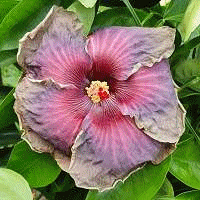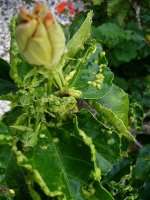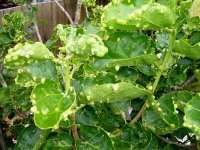 |
Blooming Hibiscus Growing Each Day |
|
A few of my Hibiscus
HOME PAGE EMAIL HIBISCUS Cutting Propagation LINKS to Hibiscus Sites |
Hibiscus Pests and Diseases
The prevalent Pests and Diseases for hibiscus growers vary from place to
place around the world. This justifies the various quarantine laws in
the different countries. Treatment varies too as different governments
authorize chemicals for use in their areas. I try to rotate the types of
chemical used in the garden to prevent the insects building up a
resistance. BIFENTHRIN and IMIDACLOPRID used together is now my spray of choice, mainly because, for the time being, it gets those pesky pollen beetles which now seem to be resistant to most other sprays. The advantage in using these two chemicals together is that one works on contact, whereas the second is stored within the plant for some time. Another good multipurpose spray to use is Baythroid which uses BETA-CYFLUTHRIN as the active ingredient. The Monolepta beetles swarm in spring here attacking Tipuana and Cassia trees, shredding the flowers. They then drop to the hibiscus and turn flowers into lace and shred buds and young leaves. CHLORPYRIFOS or CARBARYL works wonders and creates a carpet of dead beetles under the bushes very quickly. Take care when using CHLORPYRIFOS as it will cause leaf drop.
For those with a manageable number of hibiscus, it is better to pick off
your old flowers and dispose of them in a bin bag. This breaks the
beetle breeding cycle where the young feed in the mushy old flower, then
bore into the ground to pupate and later emerge as beetles to repeat the
process. White containers, (I use ice-cream containers), with just a
little water and a drop of detergent to break the surface tension also
attract beetle to the trap where they sink and drown. Another systemic spray currently available is Trifend, (TAU-FLUVINATE with MYCLOBUTANIL) as the active ingredients. This spray is good for Aphids, Thrips, Whitefly and acts a Miticide for Two-spotted mite. You can also use Baythroid as a contact spray. WHITE FLY
I
had a nasty experience the first time I found this pest, brought home on
some abutilons. Months later when I noticed the swarms of tiny insects,
I bagged some and took to the local Department of Primary Industries
office - and they were sent to their Brisbane based entomologist who
just happened to be away for six weeks. On his return and recovering my
sample from his freezer, he identified the white fly, but did not know
which one! He referred me to an Experimental Station supervisor who gave
these instructions which worked - I have never had them since. I also
used this to clear up huge infestations on other hibiscus properties. Another chemical that can be used effectively on white fly is Trifend, (TAU-FLUVINATE with MYCLOBUTANIL).
White oil is available from garden nurseries, but you also mix your own
at home. The oil mix I used effectively was 250 mL of Canola Oil and 150
mL of concentrated washing up detergent. This I put in a 2 litre milk
bottle, adding water, little by little, shaking in between to emulsify
(aerate) the mixture. After the froth settled, I made this up to onr
litre and use 100 mL per 100 L of my spray tank. SCALE
(In particular White louse scale or Citrus snow scale): This
needs a Confidor and oil mix, but with a stronger oil concentration. I
have also found that Malathion in a normal mix with oil can be sprayed
on the stems of the hibiscus and up into the foliage avoiding the leaves
(it can burn the foliage). Unfortunately, the dead scale insects stay on
the plant and need to be hosed off). Oil alone works for many scales.
Spraying the stems with cooking oil (often Canola) aerosols is effective
but must not be sprayed on the foliage. It will not kill the plant but
will cause the leaves to die and recovery with new growth will take a
while. Another chemical I have success with is ACEPHATE 970g/kg, currently sold as Lancer 970.
ERINOSE MITE The comments from the DPI include:
Colony characteristics Control Affected plants should be pruned to improve their appearance prior to spraying. Existing galls will persist on the plant until the affected tissue dies, making it difficult to judge the success of sprays. The aim of the spray program is to protect new growth. The Department of Primary Industries has obtained a special (board) approval for the use of chlorpyrifos to control this pest in cropping situations. Applied as a spray at four weekly intervals throughout the year, chlorpyrifos appears to protect hibiscus in high risk localities. In particular, frequent sprays are needed during the main growth period to renew protection. There is no chemical currently registered for use in the home garden against this pest. To avoid spreading this problem, enthusiasts are reminded not to move cuttings from infested areas into other districts. Badly effected shrubs and prunings should be removed and either burnt, buried, or taken to the dump in an enclosed plastic bag. My personal view! (Click an image for a larger picture) The best treatment is to prune as much of the affected material as possible and dispose of it in sealed bin bags. Then treat the branches remaining with Rogor, a well-known miticide which, unfortunately, affects Hibiscus foliage (which you will have pruned).
Now feed the plant with some good fertiliser like Nitrophoska and water
well. |

